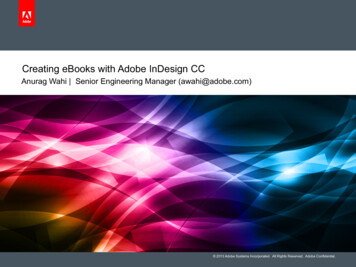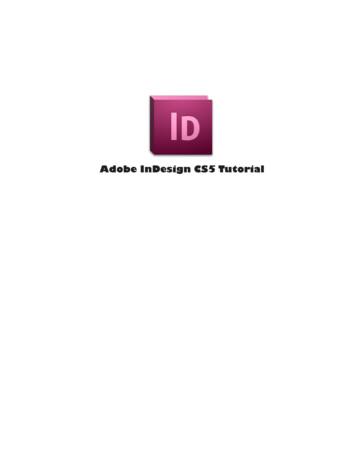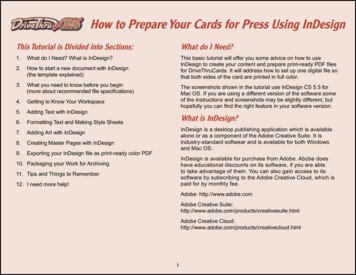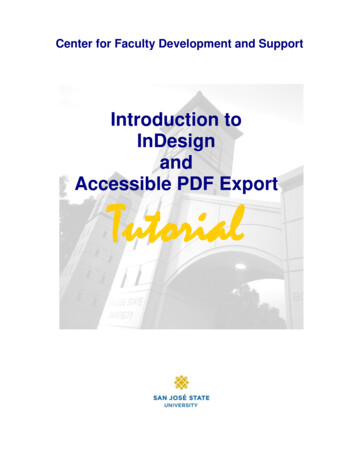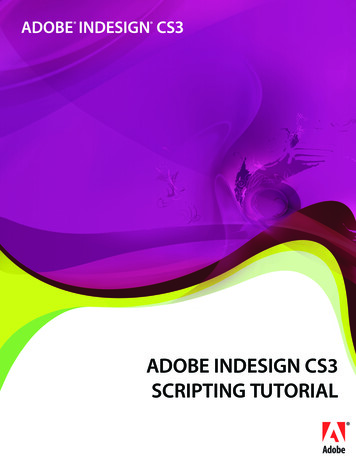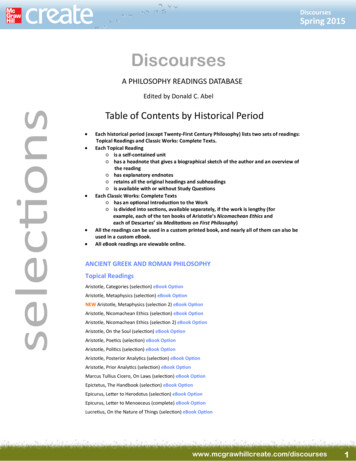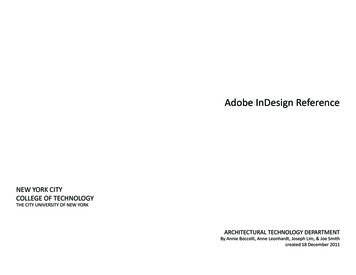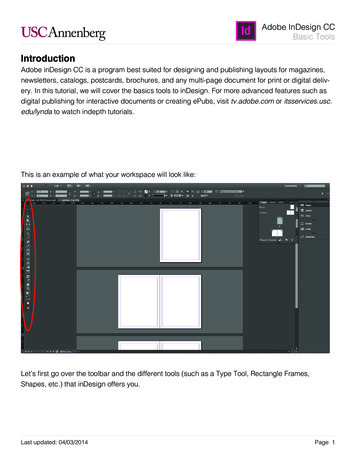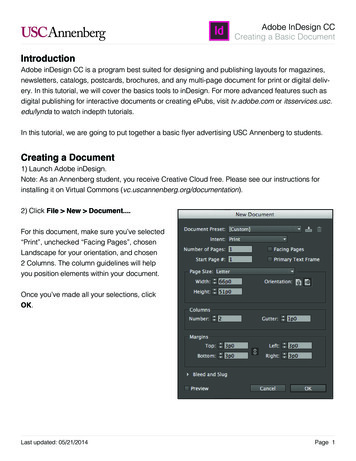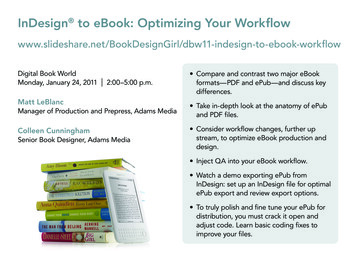
Transcription
InDesign to eBook: Optimizing Your design-to-ebook-workflowDigital Book WorldMonday, January 24, 2011 2:00–5:00 p.m.Matt LeBlancManager of Production and Prepress, Adams MediaColleen CunninghamSenior Book Designer, Adams Media Compare and contrast two major eBookformats—PDF and ePub—and discuss keydifferences. Take in-depth look at the anatomy of ePuband PDF files. Consider workflow changes, further upstream, to optimize eBook production anddesign. Inject QA into your eBook workflow. Watch a demo exporting ePub fromInDesign: set up an InDesign file for optimalePub export and review export options. To truly polish and fine tune your ePub fordistribution, you must crack it open andadjust code. Learn basic coding fixes toimprove your files.
ComparingPDF vs. ePub
PDF and ePub are two of themost popular formats for eBooksPDF is a good format for publications in which the designgives context to complex content and when the digitalpublication needs to mirror its printed counterpart.ePub is a good format for publications in which the contentis more important than the design. An ePub file is changing,flowable, and portable across many reading devices.
Comparison of Popular eBook FormatsPDFePub AND KINDLE Choose for control over design andpresentation of content Choose for content that is flowable andportable across many devicesIdeal for content that needs a complex layout,structure, and formattingIdeal for straight text and content that does notrequire a lot of formattingRetains text formatting of your print version nomatter what reading device it’s onePub eBooks depend on software to be openedand read. People have control over font selectionand type size.Usually needs a larger screen on the readingdevice for viewing without having to scrollScreen size on the reading device doesn’t matterPublication can retain page references since textis static and not reflowableContent cannot contain page references as textwill reflowGraphics can retain detail since PDFs are mostlikely read on large color screensGraphics may lose detail on small, e-ink black andwhite screens
Popular Accounts and Accepted FormatsACCOUNTS.pdf.ePub AmazonGoogle.mobi.azw Apple Barnes & Noble Sony Kobo Overdrive Blio
Print to eBook Workflow
Editorial and Content Development:Easy upstream fixes to include electronic formats Be conscious of crafting content specifically for one channel.Look at new ways of cross-referencing information that willcreate a more effective ePub product. Hyperlinks should be set up at the earliest point, preferablywith the author or the content editor in the word processingsoftware. Metadata must be as robust and as extensive as possible tomake it easy for consumers to find your content.
The Project Triangle and In-House eBook Workflowsslower turnaround on complex contenthigher costhigher qualityPro: Outsource to high-qualityvendor and achieve qualityproductTIMEquicklower costlower qualityQUALITYCOSTCon: Endure highercosts than producingin-house, more vendorcommunication andtraffickinghigher qualityup-front costs and traininglong-term savingsPro: Outsource to low-cost vendorand forgo quality control forquick turnaroundPro: Train or hire in-house eBookproduction team and achieve long-termsavings and in-house quality controlCon: Lower-quality product leads tounpredictable reading experienceCon: Endure extensive learning curveand budget for additional resources atstart up
Quality Assurance
Inject QA into your eBook workflow! Validation Tools:EPubCheck: Useful in adhering to the ePub standard, but it does not necessarilyapply to every account accepting ePub.No good validation tool for enhanced ePubs—must be created to account specs. Content and Design:Digital design needs to be as important as print design—think of all the print design quality checkpoints and see how they can apply to eBook design.Involve editorial much as you would with print design and have your editor/author review to be surethe book translates to an eBook format. The more complex and styled an eBook gets, the greaterthe need to bring the eBook work in-house because there is a greater need for editorial decisions.Remove copyrighted content specifically for print from eBook editions. Device and eReader Review:Test on multiple devices/eReaders: Note the different renderings of your ePub and share results.Pull in other stakeholders for review: Editorial, Marketing, Design, Production.
eBooks eReaders QA challengesaudio andvideo*appse-inkcolor: LED/LCD.pdf—can be read on any eReader but not sold in all NookPCsColorSamsungGalaxy TabiPadOne eBook for all devices? One eBook for a targeted device? Multiple files for targeted devices?Factors include: Budget for extra ISBNs and how to track salesTime for coding and design of multiple filesTrafficking different files to different accountsWhat content is best suited for which device What eReader your consumer is most likely toaccess your content on How much linking and interactivity your marketsexpect/content needs*Apple and Amazon (only read on the Kindle App for the iPad/iPhone) are currently the only accounts that accept ePub with audio/video. The Amazon files are .mobi format using HTML5 audio and video tags and are not uploaded through Amazon’s DTP.
PDF and ePub Best Practices
Best Practices—PDFInDesign file preparation: Make sure that cross references to the textAdobe Acrobat editing: Merge front cover and interior together intoand hyperlinks to the Web are implementedto create a fully-functioning digital publication. Set up in InDesign and check in thePDF. Create the TOC menu in addition toInDesign export options: Cross-reference the index. Select export options to keep the file size aslow as possible.a single PDF file.bookmarking with cross-references. Experiment with the audio and videoembedding features.Test: Test on multiple eReading devices.
Best Practices—ePub:1. Create or prepare file / export2. Unzip (if necessary)3. Edit4. Zip (if necessary)5. Validate6. Test7. Convert from ePub to Kindle format (if necessary)
Best Practices—ePub:Front EndInDesign file preparation: Tools for visual hierarchy of content: fontweight, font size (in relation to other content),white space, and indents. Style text with paragraph and characterstyles to translate into HTML. Replace multiple returns with space attachedto paragraph styles—they register as nospace. Remove soft returns in running text—they register as hard returns. (CS4) Thread text in order. Anchor art—otherwise they are pushed to the end ofthe ePub. Convert tables to lists or art—tables are notsupported in all reading devices at this time. Replace page references in the print file withcross references to chapters or sections. (CS4) Break up a single InDesign file forsection starts and use the book palette toexport the files. Include as much in the ePub TOC menuas possible—chapter numbers, titles, andsubheads help the reader navigate quickly.InDesign export options: Choose “Defined Styles” over “LocalFormatting” to keep your ePub file size low. Consider resizing art in Photoshop for controlover output quality: 600 pixels on longest side is a good sizefor detailed images keep images less than 10 MB Avoid embedding fonts. This increases thefile size and there are rights issues.
Best Practices—ePub:Back End Unzip the ePub file (if necessary). set font preferences (see iosfonts.com)[in CSS] font-family: sans-serif; serif; [etc]; Edit the ePub file: add date metadata to content.opf file dc:date 2011 /dc:date add cover file to the content.opf filein metadata and manifest fix spacing of headers called out in TOC[in CSS] margin-top:OP TIONAL: add additional metadata make images scalable in relation to widthof eReader screen[in HTML] style “max-width: 100%;” fix list formatting[in CSS] p.bullet to li.bullet, indent 0 avoid page breaks after heads[in CSS] h1 {page-break-after: avoid;} add more space to the outside margins[in CSS] set body and @page margins to 30 embed audio/video files and set longtables in non-linear files (see ebookarchitects.com for examples of how to dosome ePub enhancements)use HTML5 audio and video tags add cross-referencing to the index[in HTML] add color Zip the ePub file (if necessary). Validate. Test on multiple devices—check: formatting (spacing, indents, characterstyling, capitalization, page breaks) TOC clickable menu works cross-references work hyperlinks work (“&” will break a link)
Best Practices—ePub: Converting to KindleInDesignePub InDesign does not export directly to theKindle format, so use conversion softwareon an InDesign-generated ePub file such asKindlegen (use on the content.opf file only fora cleaner conversion). However, according InDesign Secrets.com:Amazon released a free plug-in that allowsInDesign users to export to Kindle format. TheKindle for Adobe InDesign (Beta) works withInDesign CS4 and CS5 in Windows XP, Vista,Windows 7, Mac OS 10.5 (“experimental”) and10.6. Mac users are advised to run SecurityUpdate 2010-005 before leaseskindle-for-indesign-plug-in.phpUse with managed expectations.Kindle (.mobi, .azw, .prc) It’s recommended that the newer version ofKindlegen (v1.1) only be used for files withaudio/video. Otherwise, the new versionneedlessly inflates eBook’s file size. Upload converted file to the Kindle Previewerto validate and check formatting. Common changes to formatting duringconversion include: lost space betweenparagraphs, lost hanging indents, imageresizing on the Kindle (small images areexpanded to fit screen unless dimensions areset inside the image tag). Amazon Kindle Publishing Guidelines (v1.3)has specific instructions regarding how tocode the cover in the content.opf file. Theirpreferred format for the cover is a JPEGimage of 600 x 800 pixels.
Format Assessment QuestionnaireContent that makes for a good ePub candidate for e-ink eReaders generally consist of straight runningtext and is not design heavy. If you answer YES to any of the below questions, there’s a very goodchance that it will be a challenge to get your publication in the ePub format for an e-ink device.However, tablet eReaders may support more of the following: Does your content have a high volume of floating design elements (sidebars, boxed text, recipes,tables, worksheets, checklists, call-outs, captions, footnotes, etc.)? Print to ePub conversion requiresa close study of the book flow design. Is your content image-heavy, containing a high volume of content-critical images? Note: Puzzlesand other fill-able content are not good ePub candidates on any eReader and may be more suitedto apps. Does your content require decorative design elements (spot art, background images, and fancycustom fonts) in order communicate the context of the content? Does your content contain complicated tables? Is your content/art dependant on being displayed in color? Does your content have a high volume of referenced page numbers or hyperlinks? How much timecan you spend on providing that? Note: Referenced page numbers should be changed to linkedcross-references and a high volume of hyperlinks can slow down an e-ink reading device.
Action Plan and Resources
Action Plan Download and read digital content yourself. Customize your print to digital workflow for your own audience andstart with the resources you already have. Test, test, and retest. Keep researching and learning.
2011/indesign-to-ebook-resourcesUse the #ePrdctn hashtag for questions on TwitterColleen Cunningham is @BookDesignGirl on Twitter
stream, to optimize eBook production and design. Inject QA into your eBook workflow. Watch a demo exporting ePub from InDesign: set up an InDesign file for optimal ePub export and review export options. To truly polish and fine tune your ePub for distribution, you must crack it open and adjust code. Learn basic coding fixes to
